CTEL 2: Assessment and Instruction
The Assessment and Instruction subtest has 60 multiple-choice questions and 2 essays.
This subtest has 3 domains, each with specific competencies:
Assessment of English Learners
- Principles of Standards-Based Assessment and Instruction
- Role, Purposes, and Types of Assessment
- Language and Content-Area Assessment
Foundations of English Language/Literacy Development and Content Instruction
- Foundations of Programs for English Learners
- Foundations of English Language Literacy
- Instructional Planning and Organization for ELD and SDAIE
- Components of Effective Instructional Delivery in ELD and SDAIE
- Effective Resource Use in ELD and SDAIE
Approaches and Methods for ELD and Content Instruction
- ELD-Approaches and Methods
- ELD-Listening and Speaking
- ELD-Reading and Writing
- Specially Designed Academic Instruction in English (SDAIE)
So, let’s start with Principles of Standards-Based Assessment and Instruction.
Principles of Standards-Based Assessment and Instruction
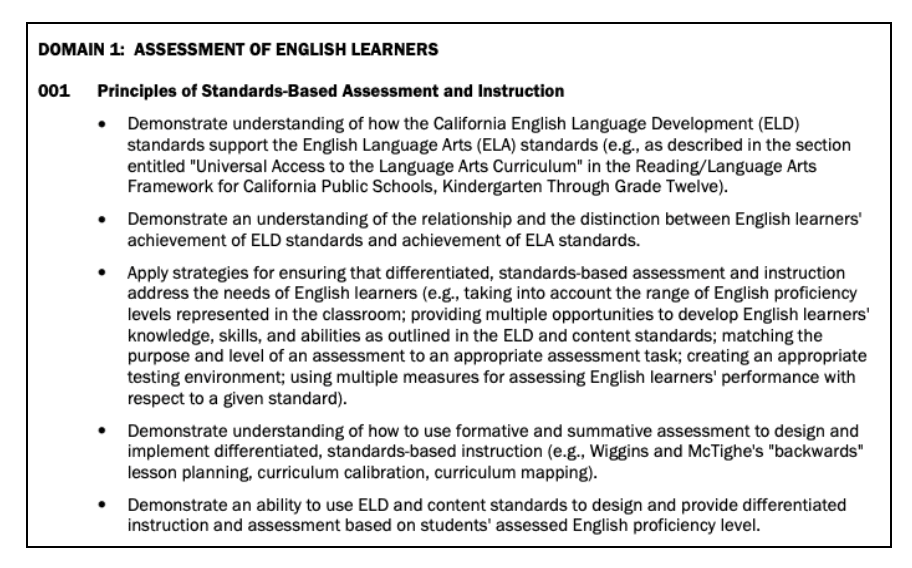
This section tests your knowledge on designing and implementing appropriate instruction and assessments to meet the academic needs of English learners at varying stages of English language acquisition.
Let’s discuss some concepts that will more than likely appear on the test.
Wiggins and McTighe’s “Backwards” Lesson Planning
“Backwards” lesson design refers to the process of setting goals and designing assessments before planning lessons to teach an objective. It helps implement standards-based instruction before the standard is the starting point and focus of the design process. The process also allows the educator to think through the different learning styles and needs of individual students and plan instruction accordingly.
Curriculum Calibration
Curriculum calibration is a process in which an assignment given to students is examined through the lens of the skills students need to complete the assignment successfully and how well those skills align with the actual learning objective. This process helps implement differentiated, standards-based instruction, because if the standard is not clear or does not correlate with the assignment to meet the needs of all learners after the examination process, the next step is to revise the assignment until it does.
This section tests your knowledge on designing and implementing appropriate instruction and assessments to meet the academic needs of English learners at varying stages of English language acquisition.
Let’s discuss some concepts that will more than likely appear on the test.
Wiggins and McTighe’s “Backwards” Lesson Planning
“Backwards” lesson design refers to the process of setting goals and designing assessments before planning lessons to teach an objective. It helps implement standards-based instruction before the standard is the starting point and focus of the design process. The process also allows the educator to think through the different learning styles and needs of individual students and plan instruction accordingly.
Curriculum Calibration
Curriculum calibration is a process in which an assignment given to students is examined through the lens of the skills students need to complete the assignment successfully and how well those skills align with the actual learning objective. This process helps implement differentiated, standards-based instruction, because if the standard is not clear or does not correlate with the assignment to meet the needs of all learners after the examination process, the next step is to revise the assignment until it does.
Role, Purposes, and Types of Assessment
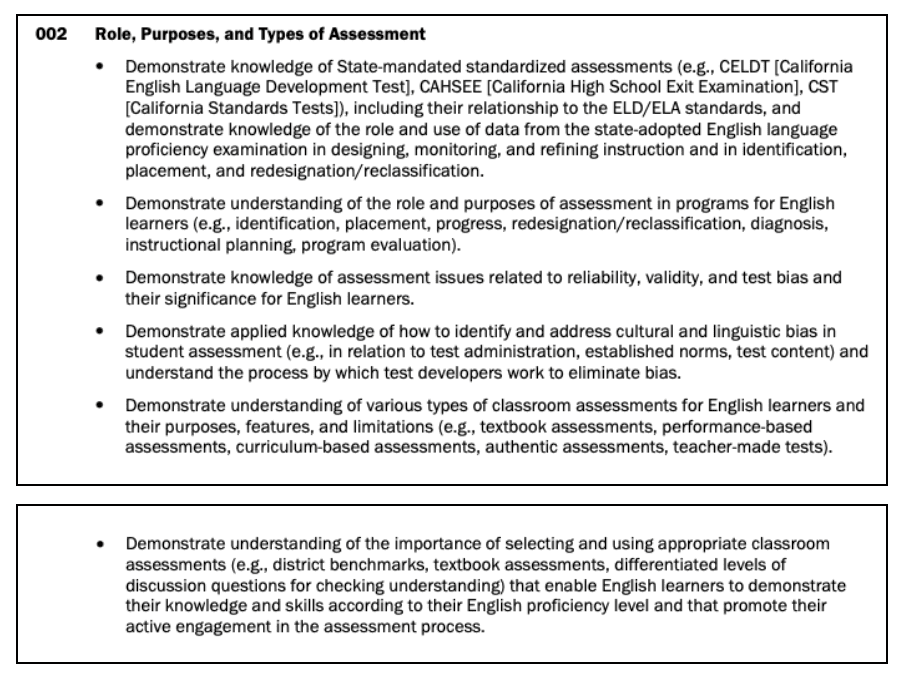
This section tests your knowledge on when and how to use various forms of assessment to meet the needs of English learners.
Here are some concepts that you might see on the test.
Test Bias
Test bias is a notable difference in test performance between groups of test-takers based on categories such as gender, race, or ethnicity. This is a significant issue for English learners, because a deficit in proficiency of the language the test is given in may not accurately assess the content of the test.
Performance-Based Assessment
Performance-based assessments are tasks students complete to measure progress towards mastery of a standard. For example, a student may be asked to design a field day station that includes concepts covered in a science unit over force and motion as opposed to taking a multiple-choice test that covers the same material. The purpose of performance-based assessment is to assess students in a meaningful way that could be applied to a real-world situation.
Performance-based assessments are authentic, open-ended, and focused on the process and product. Limitations of performance-based assessments include the subjectivity involved in scoring and the time-consuming complexity of creating them.
Language and Content-Area Assessment
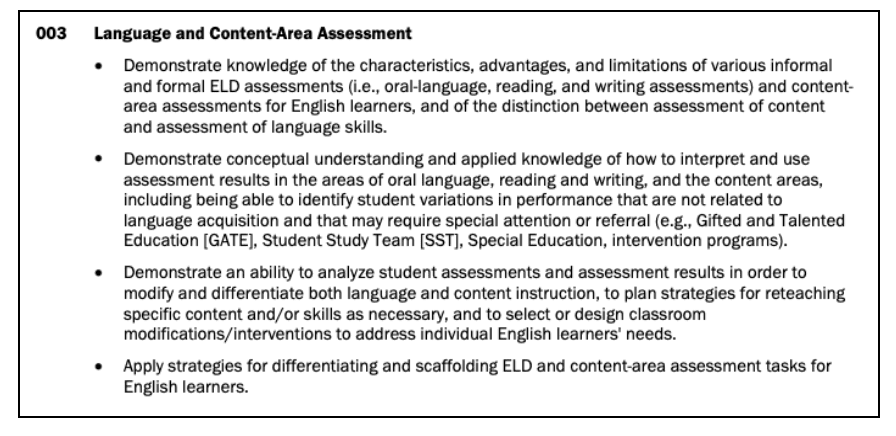
This section tests your knowledge on when and how to use various assessments to assess both English language skills and other content appropriately.
Let’s look at a specific concept.
Assessment of Content versus Assessment of Language Skills
Assessment of content means students are assessed on grade-level standards across the subject areas. Assessment of language skills means students are assessed on proficiency of communicating in a certain language. Teachers need to be aware of the distinction to ensure they design assessments that accurately measure the targeted skill.
Foundations of Programs for English Learners
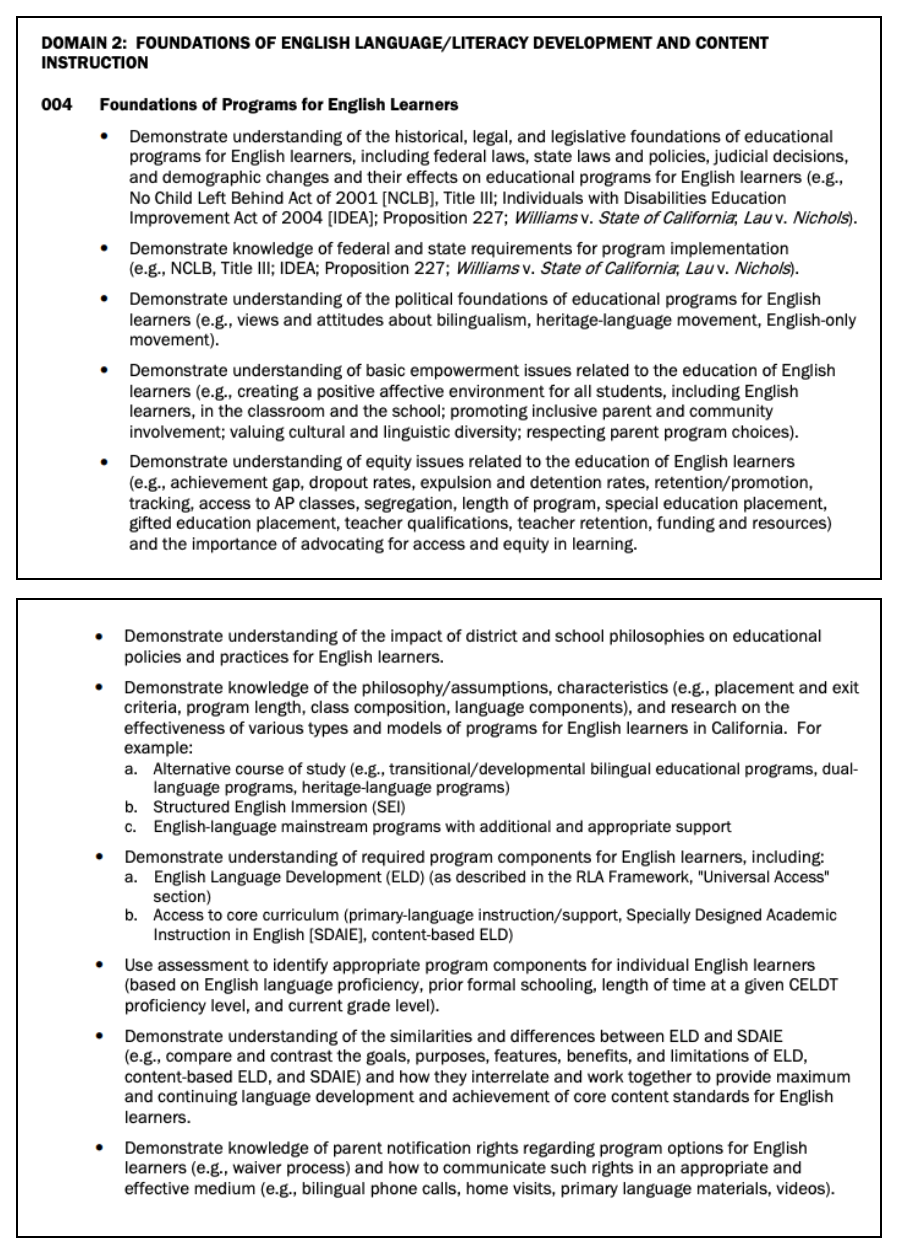
This section tests your knowledge on how various programs implemented for English learners have influenced how they are educated and assessed.
Let’s discuss some concepts that will more than likely appear on the test.
No Child Left Behind Act of 2001 [NCLB]
The No Child Left Behind Act of 2001 is an act of Congress with a focus on closing achievement gaps and ensuring that all students have an opportunity to receive a high standard of education. It became necessary for states and school districts to demonstrate progress made by English learners throughout the school year with a rating system.
Proposition 227
Proposition 227 was a state statute on the California statewide ballot in 1998 that was approved. It changed the way LEP (limited English proficient) students were educated in California. Once Proposition 227 passed, LEP students were educated in classes taught primarily in English. Most bilingual classes were eliminated, and the time LEP students spent in special classes or programs was shortened to no more than a year.
Heritage-Language Movement
The Heritage-Language Movement is the desire of minority groups to relearn or improve their speaking skills in their native language.
Structured English Immersion (SEI)
Structured English Immersion is a strategy to teach English learners English at a fast pace. Most class time is devoted to developing proficiency in English. Other academic content is not the focus.
Foundations of English Language Literacy

This section tests your knowledge on developing English language reading and writing proficiency by the use of strategies that promote foundational literacy skills.
Here are some concepts that you may see on the test.
Language Experience Approach
The language experience approach is a shared literacy experience between the student and teacher in which the student’s personal experience becomes the basis for a text transcribed by the teacher. It is used to develop English learners’ reading and writing proficiency in English across the curriculum, because the text is revisited and expanded on to teach and model concepts like grammatical structures using a familiar experience that is meaningful to the learner.
Pre-Reading Activities
Pre-reading activities allow readers an opportunity to preview the text and activate any prior knowledge that may help them with comprehension. Some pre-reading activities to help develop English learners’ reading and writing proficiency include brainstorming, discussing, and paying close attention to the title and pictures. The teacher should prepare simple questions to guide the pre-reading experience.
Instructional Planning and Organization for ELD and SDAIE
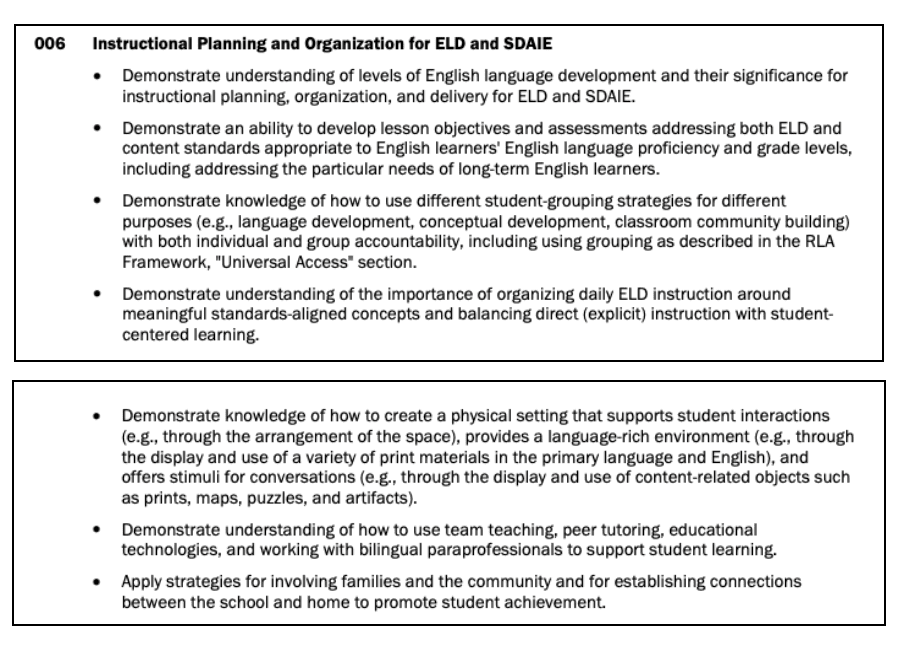
This section tests your knowledge on setting up and managing a classroom that promotes both English language development and mastery of content across the curriculum. It also tests your knowledge of encouraging student interaction and community involvement to enhance students’ educational experience.
Let’s discuss some concepts that will more than likely appear on the test.
Student Grouping Strategies
To promote language development, conceptual development, and classroom community building, teachers can arrange the physical space of the classroom to encourage student interactions. Desks can be arranged in groups or pods as opposed to an individually placed arrangement.
Team Teaching
Team teaching is the coordinated effort of a group of educators working toward common goals of student achievement. It can be used to support student learning, because multiple teachers work together to plan, design, implement, and evaluate powerful instruction. Team teachers can also use flexible grouping to meet with small groups of students with similar needs.
Components of Effective Instructional Delivery in ELD and SDAIE

This section tests your knowledge on strategies used to deliver effective instruction for English learners.
Let’s discuss some concepts that will more than likely appear on the test.
Cummin’s Four Quadrants
Cummin’s Four Quadrants is a model that divides language tasks into four categories. Moving vertically, the scale goes from cognitively undemanding tasks to cognitively demanding tasks. Moving horizontally, the scale goes from tasks with a lot of context with which English learners can easily relate to abstract tasks with little to no context for English learners.
Levels of Comprehension
Literal comprehension
involves understanding information that the author explicitly writes in the text. Examples of demonstrating literal comprehension include identifying the main idea and supporting details, sequencing events, locating specific information, and summarizing.
Inferential comprehension
involves understanding the meaning behind the author’s writing. Examples of demonstrating inferential comprehension include identifying theme, the author’s purpose, and why characters feel or act the way they do, and making predictions.
Evaluative comprehension
involves understanding why the author made the choices he or she did when writing a particular text. It requires the reader to use his or her own experience to evaluate the writing. An example of demonstrating evaluative comprehension includes agreeing or disagreeing with the author supported by reasons why or why not.
Effective Resource Use in ELD and SDAIE
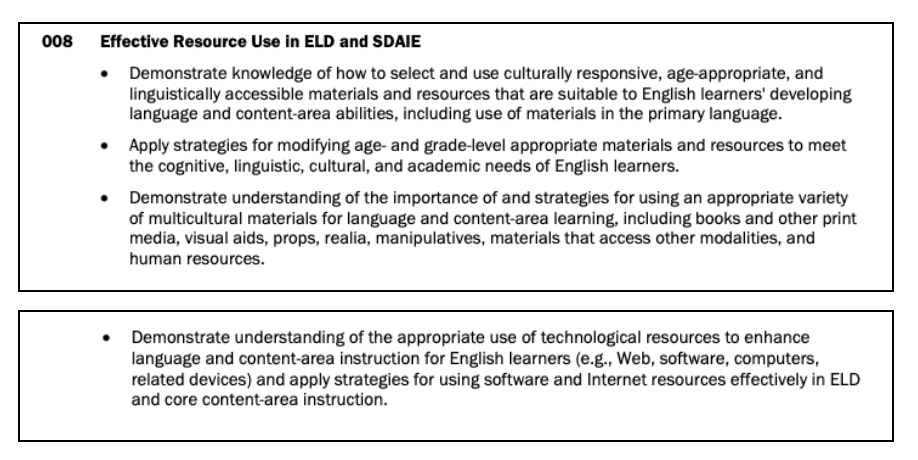
This section tests your knowledge on choosing and using appropriate materials for English learners, with attention to culturally responsive resources.
Here’s a concept you may see on the test.
Technological Resources
English learners can benefit from a variety of technological resources, such as computers and other devices, document cameras, interactive whiteboards, and various programs, apps, or software. These technological resources can be effective in providing English learners with much needed visual examples (photographs, videos, graphics, etc.) of vocabulary and concepts. Students can also express themselves and demonstrate their learning in a visual way using technology.
ELD-Approaches and Methods
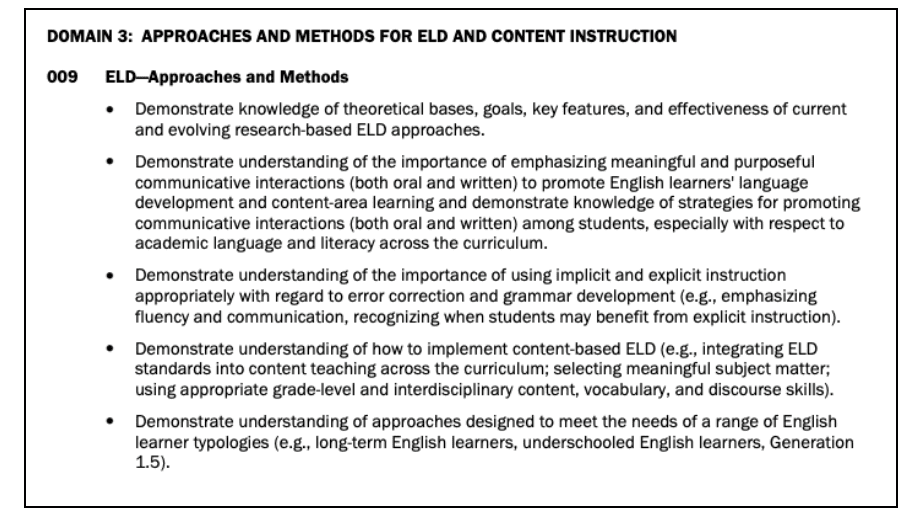
This section tests your knowledge on effective approaches and methods to teach English learners both English and other content-area standards.
Take a look at these concepts.
Implicit and Explicit Instruction
Implicit instruction is a less formal way to teach language skills. It can involve encouraging conversation in English between students with guiding questions or showing a video in English. The idea is that English learners will naturally pick up grammar and vocabulary through these types of communicative experiences.
Explicit instruction is direct teaching of a specific skill. It could involve teaching a particular grammar rule or set of vocabulary words and assigning students to practice using them correctly on a written assignment.
Generation 1.5
Generation 1.5 is a term used to describe individuals who arrived in the United States in their youth. This is a unique population because their identities may feel split between their native home and their home in the U.S. Generation 1.5 is typically still acquiring the English language and will require language acquisition support. They may also have strengths to be drawn on as multilingual learners.
ELD-Listening and Speaking
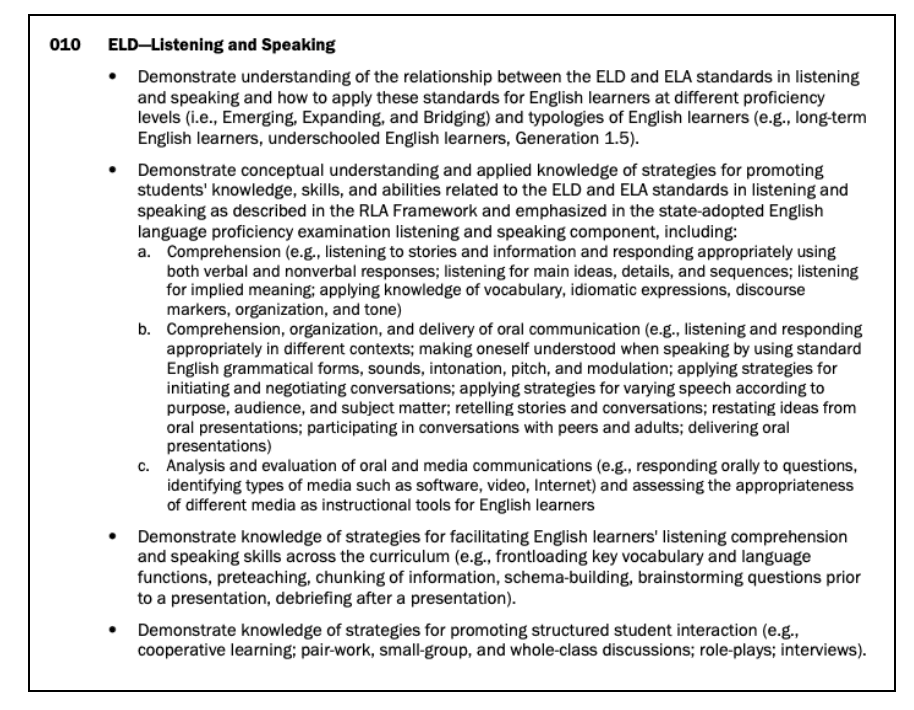
This section tests your knowledge on strategies to use to promote English learners’ listening and speaking skills.
Let’s discuss some concepts that will more than likely appear on the test.
Frontloading Vocabulary
Frontloading vocabulary means to pre-teach words that students need to know in order to be successful in learning a particular skill or completing a certain task. It facilitates English learners’ listening comprehension and speaking skills by preparing them for words they may hear or will need to say in the future task or assignment.
Structured Student Interaction
Structured student interaction provides opportunities for students to work together in class. Teachers should consider arranging the physical space of the classroom to promote structured student interaction. Teachers should also consider work habits, personalities, and skill levels of students when grouping them for particular tasks. Students can work together in different ways, such as:
- Cooperative Learning: Students work in groups on tasks that involve both academic and social experiences.
- Pair-Work: Students work with a partner to complete a task.
- Small-Group: Students work in groups of about 3-5 to complete a task.
- Whole-Class: Students interact with their whole class in a structured way. Examples include discussions, debates, and giving/receiving peer feedback.
- Role-Plays: Students take on roles and act out different scenarios.
- Interviews: Students ask and answer questions for each other.
ELD-Reading and Writing
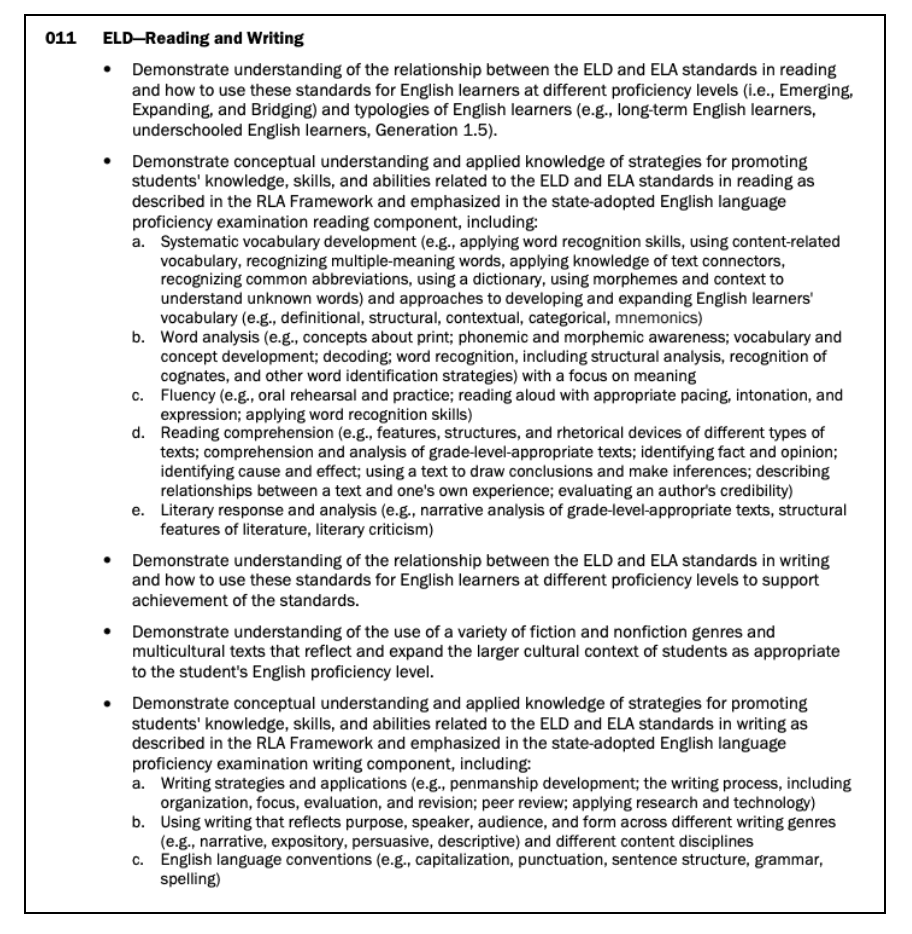
This section tests your knowledge on strategies to use to promote English language learners’ reading and writing skills.
Take a look at these concepts that might come up on the test.
Systematic Vocabulary Development
Systematic vocabulary development is direct vocabulary instruction. The basic procedure for explicitly teaching a new vocabulary word includes introducing the word, giving a definition of the word that is meaningful to students, and using the word in a variety of examples. The teacher then checks for students’ understanding and coaches them in the use of the new word. It promotes vocabulary development for English learners by directly teaching them new, intentionally chosen words using a systematic method.
Multicultural Texts
Multicultural texts are literary works that include characters from a variety of backgrounds. They are important to use so students have exposure to other cultures and also so students can see their own culture represented in texts shared with their class. Students learn to value their own and other cultures through the use of multicultural texts in the classroom.
Specially Designed Academic Instruction in English (SDAIE)
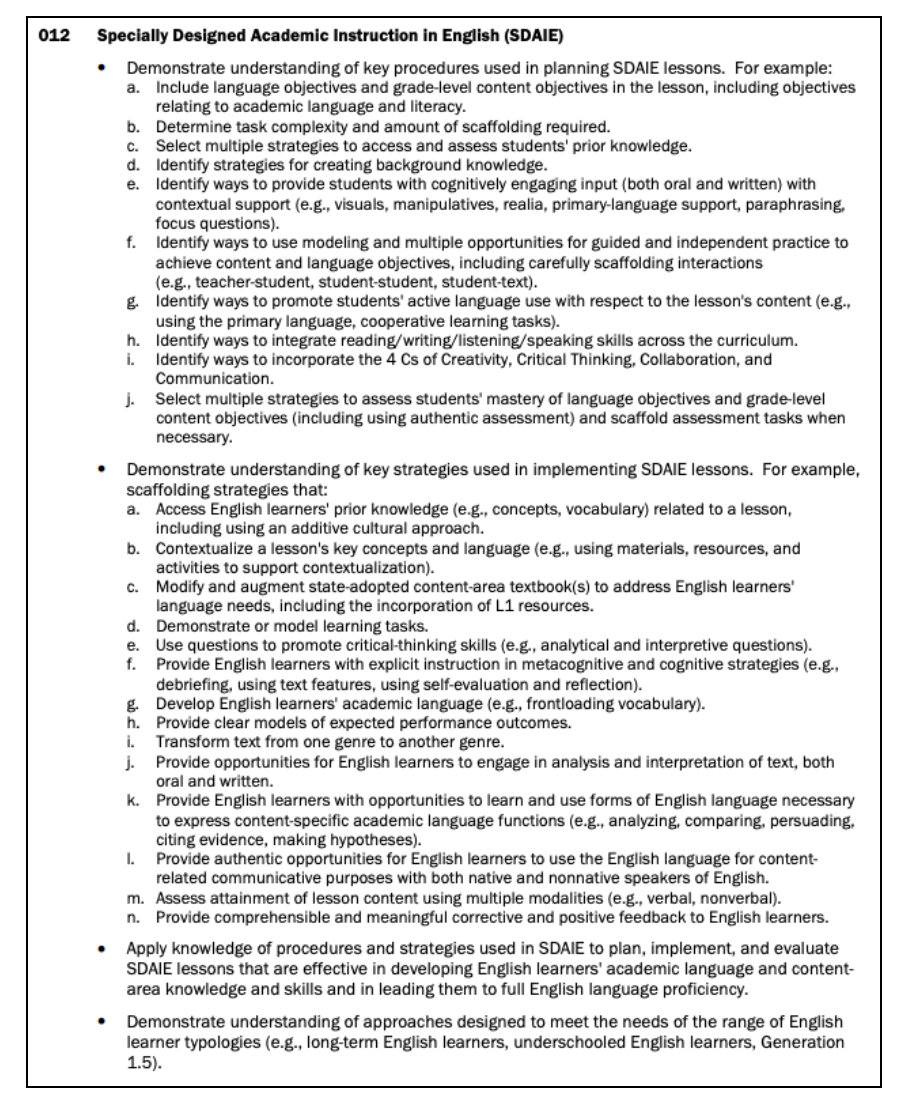
This section tests your knowledge on the procedures and strategies to use to successfully implement SDAIE in the classroom.
Here are some concepts that will more than likely appear on the test.
SDAIE
SDAIE is Specially Designed Academic Instruction in English. It is an approach to teach students English and other academic content simultaneously. Key components of SDAIE include:
- focus on academic vocabulary/directly teaching new vocabulary
- active learning in which the students demonstrate learning to their teacher
- activating/assessing prior knowledge
- intentional student grouping
- acknowledging/affirming individual student differences and contributions
- teacher modeling of verbal skills
- graphic organizers with pictures or words
- integration of language skills including listening, speaking, reading, and writing
- high-level thinking skills
- intentional questioning
- teacher takes on role of facilitator
Debriefing
Debriefing is to review and discuss a task after completion. Explicit instruction in debriefing means to directly teach and model the process with a student.
And that is some information about CTEL 2: Assessment and Instruction.
